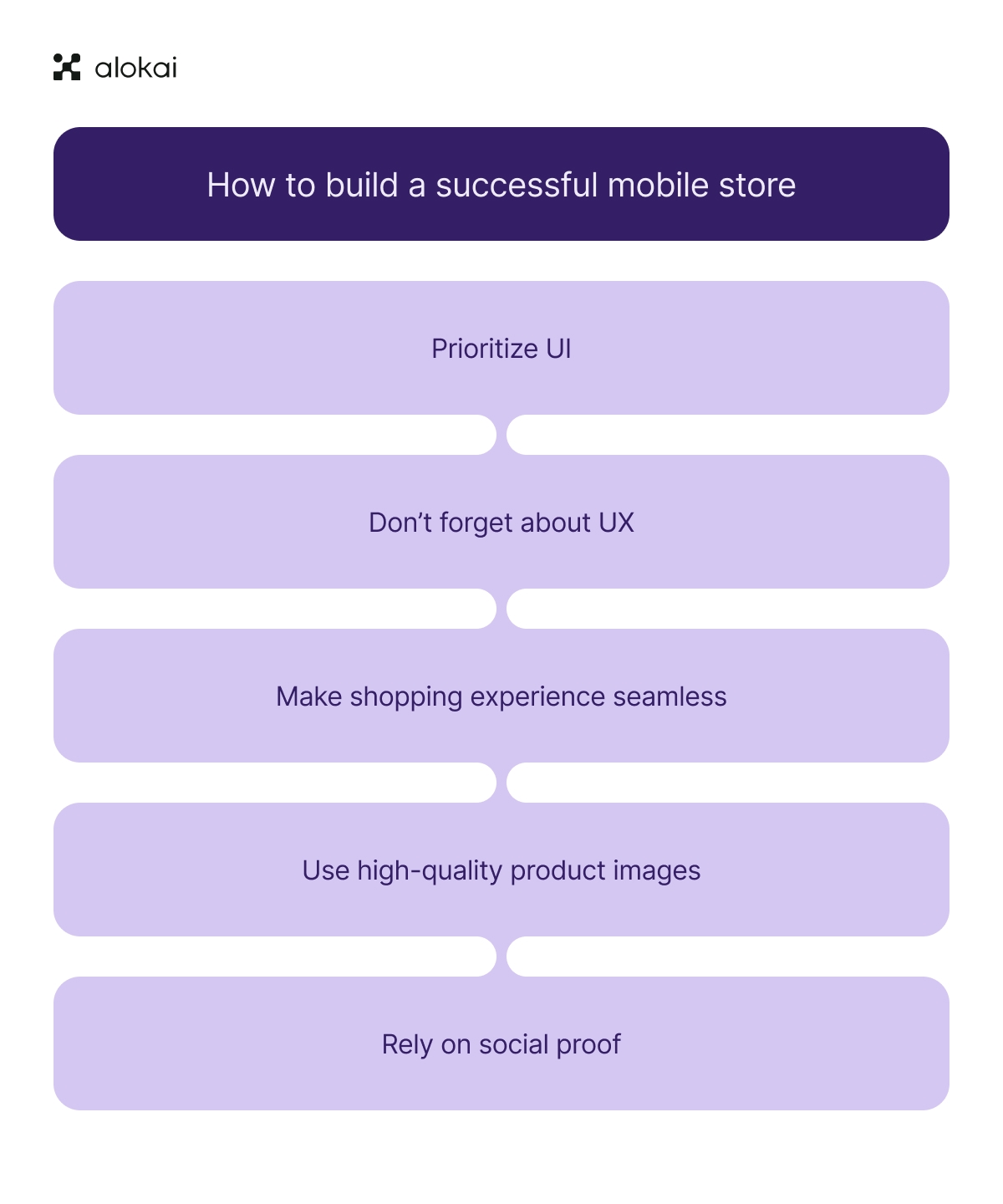Mobile ecommerce design is all about optimizing the shopping experience. With more consumers using mobile apps to shop, businesses must focus on creating user-friendly and seamless designs. This article covers essential tips, key features, best practices, and future trends to help you craft a successful mobile ecommerce design.
Key takeaways
- In 2025, mobile apps are expected to dominate ecommerce, offering higher conversion rates and average order values than mobile websites.
- Key features for successful ecommerce apps include user-friendly interfaces, personalization, integration of AR, and multiple mobile payment options to boost user interaction.
- Best practices for mobile ecommerce design emphasize prioritizing UI/UX, incorporating high-quality visuals, and leveraging social proof to build trust and drive conversions.
Understanding the importance of mobile ecommerce design
The importance of mobile ecommerce design cannot be overstated in the current digital landscape. In 2025, 85% of consumers are expected to favor mobile shopping apps over mobile websites, highlighting their growing significance. This preference proves the need for businesses to invest in creating intuitive and user-friendly mobile apps that cater to the evolving expectations of mobile users.
One key reason for the growing preference for mobile apps is their higher conversion rates. Mobile applications are projected to yield a 157% higher conversion rate than mobile web sessions. The average order value from mobile apps is $102, exceeding the $92 average from mobile websites. These statistics underscore the potential of mobile apps to drive sales and enhance user engagement.
[please add a visual here showing the fact that mobile apps drive sales and show the data why]
Moreover, the rise of voice shopping and the importance of omnichannel retail practices further emphasize the need for effective mobile ecommerce design. Voice shopping is projected to reach $40 billion by 2023, indicating growing consumer reliance on voice assistants for purchasing. About 73% of consumers use multiple channels before making a purchase, making it essential to maintain consistency between mobile and desktop sites to ensure a seamless shopping experience.
Key features of a successful ecommerce app
A friendly UI
Incorporating key features that foster deeper engagement and drive conversions should be a primary objective for an ecommerce app. One of the most critical aspects of app design is ensuring a user-friendly interface. Effective search functionalities, quick navigation features like search bars and breadcrumbs, and a logical layout significantly improve the overall user experience.
Personalized shopping
Personalization is another essential feature that can significantly boost user satisfaction and engagement. Remembering user preferences and providing personalized recommendations creates a more tailored shopping experience.
AR & VR options
In addition to these features, integrating augmented reality (AR) virtual reality (VR) can further enhance the app’s functionality. AR provides innovative ways for consumers to visualize products in their environments, making the customer journey more interactive and engaging.
Multiple payment options
With mobile wallet transactions increasing at an annual rate of 62%, offering multiple secure payment options, including digital wallets, simplifies the checkout process and improves user satisfaction. Another popular alternative is Buy Now, Pay Later (BNPL) tech, allowing shoppers receive a product today and worry about the payment the next month.
Best practices for designing an ecommerce mobile app
To create an effective ecommerce mobile app, it is essential to adhere to best practices that cater to the needs and preferences of mobile users using a mobile device.
Elements that contribute to the overall success of an ecommerce app:
- Prioritizing user interface (UI) and
- App UX and design
- Creating seamless shopping experiences
- Incorporating high-quality product images
- Leveraging social proof

By focusing on these aspects, you can enhance the effectiveness of your ecommerce mobile app.
In the following subsections, we will delve deeper into these best practices, providing actionable tips and insights to help you design a mobile ecommerce app that stands out in 2025 and beyond.
Prioritizing user interface (UI) design
A visually appealing and functional application depends on prioritizing user interface design. Consumers prefer shopping on smartphones, necessitating seamless functionality across devices. A mobile-first approach optimizes the app experience for most users who shop via mobile, enhancing the overall app UI.
Inclusive UI/UX design broadens the potential customer base by enhancing accessibility for all users, including those with disabilities. Additionally, thumb-friendly designs and the use of a consistent color scheme can significantly enhance user engagement and brand recognition.
App UX and design
The user experience (UX) and overall mobile app design influence customer satisfaction and engagement. A visually appealing and intuitive interface can significantly impact a customer’s first impression of an ecommerce platform, establishing trust and encouraging further exploration. Emphasizing simplicity in app design helps prevent user overwhelm and confusion by focusing on essential features.
Consistency in design across UI elements fosters user familiarity, enhancing navigation and overall task execution. Readability is another important piece of the puzzle–typography and font size must be chosen carefully to ensure text is easily legible on mobile screens. Providing feedback for user actions, such as animations or color changes, ensures users know their inputs have been registered, improving usability.
Utilizing space effectively in mobile UI avoids clutter and ensures a pleasant browsing experience. Designing for thumb navigation by placing key interactive elements within easy reach enhances user comfort and accessibility. Ensuring visibility and intuitive, easy navigation further improves shopping experiences, making it easier for users to locate products and complete purchases.
Creating seamless shopping experiences
Seamless shopping experiences are fundamental to the success of an ecommerce mobile app. Approximately 79% of mobile users have purchased online using their devices within the last six months—fast loading times and intuitive navigation also influence user experience. Implementing a responsive design enhances user navigation and product visibility on mobile devices.
Consumers expect a consistent shopping experience across different platforms. Multiple secure payment options, including digital wallets like Apple Pay or Google Pay, significantly simplify the checkout experience and improve user satisfaction.
Maintaining a minimalistic layout helps users easily find categories and products without distractions. Tap-friendly call-to-action buttons enhance the buyer's journey by ensuring easy user interaction. Additionally, minimizing text input requirements during checkout can reduce abandonment rates and improve user satisfaction.
The role of high-quality product images
High-quality product images enhance user engagement and aid the customer’s decision-making process. They also significantly enhance customer trust and perceived product value. Consistent visual presentation across product images strengthens brand recognition and customer loyalty. High-quality visuals can also reduce return rates by setting accurate customer expectations.
Leveraging social proof for trust and conversions
Social proof helps building trust and driving conversions in an ecommerce mobile app. A staggering 93% of consumers report that online reviews influence their purchasing choices. Customer reviews on product pages can increase purchase probability by 270%. Negative reviews, on the other hand, can dissuade 94% of consumers from engaging with a business.
Integrating user-generated content, such as social media posts, can enhance product visibility and foster trust among potential buyers. Displaying trust badges can enhance a brand’s perceived trustworthiness for 75% of respondents.
Expert endorsements and customer testimonials in case studies add credibility and illustrate the real-world impact of ecommerce solutions.
Trends in mobile ecommerce design for 2025
As we look ahead to 2025, several trends are shaping the future of mobile ecommerce design. Mobile commerce is expected to control 73% of the global ecommerce market share.
Smartphones are anticipated to account for most mobile commerce sales, with $418.9 billion estimated in 2024. This trend underscores the importance of optimizing ecommerce apps for mobile devices to capture a larger market share.
One-click ordering functionality is set to become prevalent in mobile apps, significantly reducing shopping cart abandonment rates.
Social commerce will also evolve, allowing direct purchases through platforms like Facebook and Instagram, enhancing the buying experience.
Essential tips for effective mobile ecommerce design
Focusing on best practices that cater to modern consumers’ expectations is essential for effective mobile ecommerce design. Consumers expect fast and visually engaging online experiences, making effective UI design crucial for customer satisfaction. Options for users to save products or create wishlists can lead to higher customer retention rates.
Implementing social proof signals effectively focuses on critical points in the buying process, like checkout pages and product detail areas. A well-thought-out strategy for push notifications can keep users engaged without overwhelming them, balancing value and timing. Utilizing analytics tools like Google Analytics helps track user behavior and sales trends, informing strategies for better user engagement.
Summary
Effective mobile ecommerce design enhances user satisfaction, driving conversions, and building customer loyalty in 2025. Businesses can create a successful application that stands out in the competitive marketplace by prioritizing user interface and user experience design, creating seamless shopping experiences, incorporating high-quality product photos, and leveraging testimonials.


















